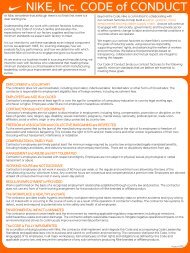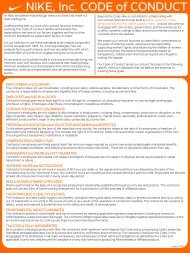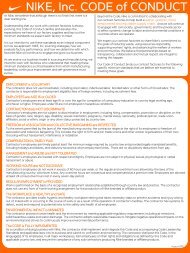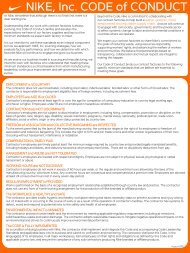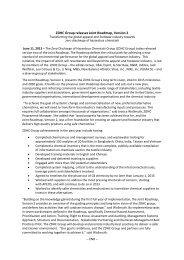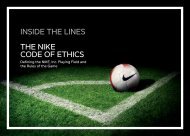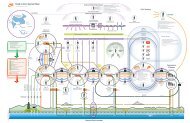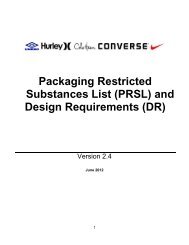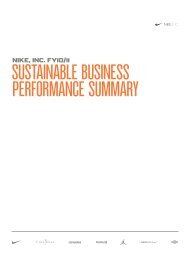COC CLS - Healthy Safety Environment - NIKE, Inc. - The Journey
COC CLS - Healthy Safety Environment - NIKE, Inc. - The Journey
COC CLS - Healthy Safety Environment - NIKE, Inc. - The Journey
Create successful ePaper yourself
Turn your PDF publications into a flip-book with our unique Google optimized e-Paper software.
HEAT STRESS MANAGEMENT<br />
b. Identifying workplace and work assignments where a potential for heat stress exists.<br />
c. Provide comfortable and safe working temperature conditions. Work temperature ranges:<br />
• Sedentary work: 16º C (60º F) - 30º C (86º F).<br />
• Work involving physical effort: 13º C (55º F) - 27º C (81º F).<br />
• If work temperature ranges cannot be maintained, heat/cold stress procedures must be<br />
implemented including the following engineering, administrative controls and/or<br />
personal protective equipment to minimize the effects of heat stress:<br />
- Provision of accessible potable drinking water sufficient to provide each worker up to<br />
one quart per hour. When temperatures exceed 30º C (86º F) ice should be provided<br />
to cool the water.<br />
- Employees must have access to shade during entire shift and as a general rule there<br />
must be enough shade to accommodate, at the same time, 25 percent of the<br />
employees on a shift.<br />
- If the interior of a vehicle is used to provide shade, it must have an air conditioner that<br />
works.<br />
- Metal storage sheds and other out-building do not provide “shade” unless they<br />
provide a cooling environment comparable to shade in open air. For example, they<br />
must be mechanically ventilated or open to air movement.<br />
- Shade must be accessible within a time frame not to exceed 200 meters or 5 minutes<br />
by walking.<br />
- Provisions for Preventative Recovery Periods (PRP). A PRP is necessary if an employee<br />
believes that a rest break is needed to cover from the heat or if an employee exhibits<br />
indications of heat illness.<br />
2. TRAINING—<br />
All employees: Non-supervisory and supervisory must be trained on:<br />
• <strong>The</strong> environmental and personal risk factors associated with heat illness.<br />
• <strong>The</strong> employer’s procedures for complying with heat illness standards.<br />
• <strong>The</strong> importance of drinking water.<br />
• <strong>The</strong> importance of acclimatization, how it is developed, and how employer’s procedures<br />
address it.<br />
Non-supervisory employees should also be trained to:<br />
• Inform the supervisor if he/she is not used to the heat and may need more frequent<br />
breaks until his/her body adjusts, which usually takes 4-14 days.<br />
• Drink water in small amounts, 3 to 4, 8 ounce cups per hour.<br />
<strong>Safety</strong> <strong>CLS</strong> – Page 2<br />
04.14.10



